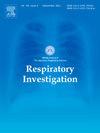Clinical significance of histological inflammation in systemic sclerosis-associated interstitial lung disease
IF 2.4
Q2 RESPIRATORY SYSTEM
引用次数: 0
Abstract
Background
Systemic sclerosis-associated interstitial lung disease (SSc-ILD) is known to have a poor prognosis and the relationships between histological findings and response to anti-inflammatory therapy or prognosis have not been well investigated.
Methods
We examined SSc-ILD patients who underwent surgical lung biopsy at a single respiratory center between 2008 and 2021 and received anti-inflammatory therapy (corticosteroids and/or immunosuppressive drugs). These patients were classified into two groups: an inflammation group, where histological evidence of inflammation defined as “lymphoid aggregates with germinal centers” or “plasmacytosis” was observed, and a non-inflammation group, where these findings were not observed. The correlation of the histological conclusions of inflammation with treatment response and prognosis was retrospectively investigated.
Results
Twenty-seven patients were included in the study; 15 (55.6%) were allocated to the inflammation group and 12 (44.4%) to the non-inflammation group. Patient backgrounds did not differ between the groups. The first annual increase in % predicted FVC was significantly larger in the inflammation group than in the non-inflammation one (from 74.3% to 85.9% vs. 75.0%–74.7%, respectively; p = 0.021). The inflammation group took significantly longer to reach end-stage lung disease, defined as an FVC <50%, needing continuous oxygen, or death (p = 0.011). They also had a trend towards longer overall survival compared to the non-inflammation group (median survival: not reached vs. 6.6 years, p = 0.083).
Conclusions
Approximately half of the SSc-ILD patients showed histological evidence of inflammation, which may influence treatment response and long-term disease progression.
系统性硬化症相关性间质性肺病组织学炎症的临床意义
背景:系统性硬化症相关间质性肺疾病(SSc-ILD)预后较差,组织学表现与抗炎治疗反应或预后之间的关系尚未得到很好的研究。方法:我们研究了2008年至2021年间在单一呼吸中心接受外科肺活检并接受抗炎治疗(皮质类固醇和/或免疫抑制药物)的SSc-ILD患者。这些患者被分为两组:炎症组,炎症的组织学证据被定义为“带有生发中心的淋巴细胞聚集”或“浆细胞增多症”,而非炎症组,这些发现未被观察到。回顾性研究炎症的组织学结论与治疗反应和预后的相关性。结果共纳入27例患者;炎症组15例(55.6%),非炎症组12例(44.4%)。两组患者的背景没有差异。炎症组预测FVC %的首年增幅明显大于非炎症组(分别为74.3% ~ 85.9%和75.0% ~ 74.7%);p = 0.021)。炎症组达到终末期肺病(定义为肺活量≥50%,需要持续供氧或死亡)所需时间明显更长(p = 0.011)。与非炎症组相比,他们的总生存期也有更长趋势(中位生存期:未达到vs. 6.6年,p = 0.083)。结论大约一半的SSc-ILD患者表现出组织学炎症证据,这可能影响治疗反应和长期疾病进展。
本文章由计算机程序翻译,如有差异,请以英文原文为准。
求助全文
约1分钟内获得全文
求助全文

 求助内容:
求助内容: 应助结果提醒方式:
应助结果提醒方式:


